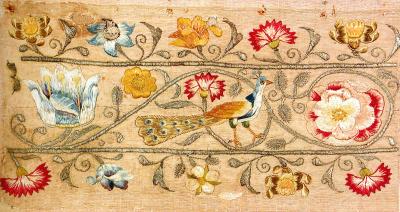
Donated by Loriano Bertini, Inv. No. 75.01.581
Sewn on a extremely fine double linen background, the main design of the embroidery is outlined in red silk backstitch while the internal area is filled with gold thread in satin stitch. The design is composed of a thick weave of voluted vine shoots which join in the centre to form a heart and an extremely complex lovers' knot. The high quality of the embroidery and the presence ot the heart and the lovers' knot motifs suggest that the embroidery was probably made for a wedding. Similar decorative patterns can be found in the embroidery collections of the Victoria & Albert Museum, still attched to original cushion covers or items of informal ladies' clothing dating back to the first quarter of the 17th century.
